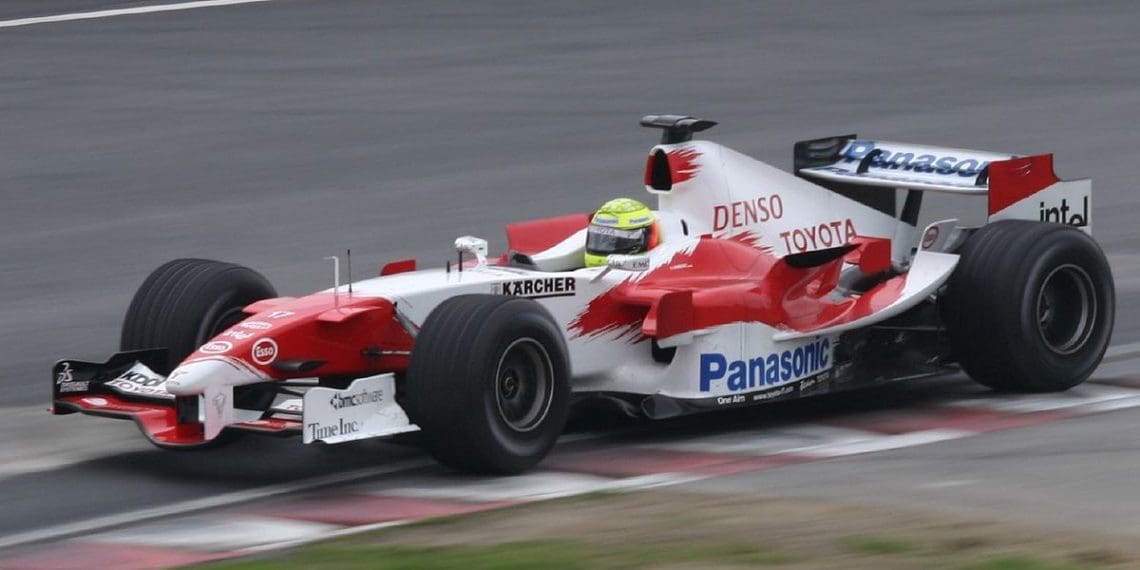Toyota’s history in Formula 1 is a classic example of how even the most powerful and well-resourced corporations can falter when they underestimate the complexities and pace of the sport. Despite entering F1 in 2002 with a massive budget and state-of-the-art facilities, Toyota’s eight-year run in the sport (2002-2009) yielded 13 podiums but not a single race victory. It was a significant disappointment for a manufacturer of its stature, showcasing the pitfalls of trying to translate road car success into Formula 1 dominance.
High Hopes and Early Missteps
When Toyota announced its F1 entry in 1999, expectations were sky-high. Given its track record in the World Rally Championship and its success with the iconic GT-One sportscar, many believed that Toyota’s deep pockets and resources would quickly translate to on-track success. However, F1 proved to be a far more challenging environment. The team’s initial missteps began with engine regulations—Toyota had invested heavily in developing a V12 engine, only for the FIA to mandate the use of V10s. This setback delayed Toyota’s official entry from 2001 to 2002 and cost them millions, marking the start of a trend where the team struggled with F1’s political and technical demands.
A Learning Curve That Never Ended
Toyota’s first car, the TF101, was heavily tested throughout 2001 but proved uncompetitive. The testing period revealed fundamental flaws, particularly a lack of downforce and an overweight chassis. This early struggle set the tone for a team that would consistently be behind the development curve, even as it ramped up operations by expanding its workforce and testing facilities.
Despite recruiting talented drivers like Mika Salo, Allan McNish, and later Jarno Trulli and Ralf Schumacher, Toyota often blamed its drivers rather than addressing underlying issues with the car’s performance. This was a recurring theme, as the team frequently cycled through drivers, including Cristiano da Matta and Timo Glock, without making the structural changes necessary to improve the car itself.
Corporate Culture vs. Racing Reality
The main issue that plagued Toyota’s F1 venture was its insistence on applying the “Toyota Way”—a corporate philosophy designed for efficiency and reliability in road car production—to the fast-paced, innovation-driven world of Formula 1. This approach led to slow decision-making processes, and the team’s corporate structure often clashed with the need for rapid, flexible solutions essential in F1.
Personnel turnover was high, as many talented individuals, including technical directors like Mike Gascoyne, found themselves at odds with Toyota’s corporate culture. Gascoyne, brought in from Renault in 2003, did improve the team’s performance, helping them achieve their best season in 2005 with five podium finishes and a fourth-place finish in the Constructors’ Championship. However, Gascoyne’s confrontational style and resistance to the corporate straitjacket led to his departure, highlighting the team’s inability to integrate strong leadership capable of pushing boundaries.
Missed Opportunities and Final Stumbles
A critical failure was Toyota’s inability to adapt its strategies effectively. When it finally showed competitive potential, such as in the 2009 season with the TF109, Toyota’s conservative decision-making undermined its efforts. Strategic errors and reluctance to take risks cost the team several potential race wins. The Bahrain Grand Prix in 2009 is a prime example: despite locking out the front row, a misguided tire strategy at the first pit stop ruined their chance for a breakthrough victory.
Toyota’s struggles were further compounded by its decision to stick with a Cologne-based headquarters rather than establishing an F1 hub in the UK, where most of the expertise and talent resided. Communication issues between the team in Germany and corporate leadership in Japan created delays and hampered their ability to respond quickly to the fast-evolving F1 environment.
What Could Have Been
Towards the end of its F1 tenure, Toyota showed glimpses of progress. The TF109 was a solid car that, with better decision-making and a bit of luck, might have delivered the team’s first win. Toyota’s decision to pull out of F1 at the end of 2009, amid the global financial crisis, came just as the team appeared to be gaining momentum. The departure of key personnel and the cancellation of the promising TF110 car left fans and analysts wondering what might have been.
Despite these glimpses of potential, Toyota’s exit underscored a hard truth: success in F1 requires not only financial resources but also a willingness to adapt and innovate rapidly—something the Toyota corporate machine was never fully prepared to do.
A Return Through Partnership
Now, Toyota is making a cautious return to Formula 1, but this time through a technical partnership with Haas. The collaboration will allow Toyota to re-engage with F1 without the pressures of running its own team, providing technical support while benefiting from the expertise of an established F1 outfit. Whether this partnership can help Haas climb the competitive ranks remains to be seen, but it certainly reflects a more calculated and less hubristic approach from Toyota compared to its ill-fated solo effort.










